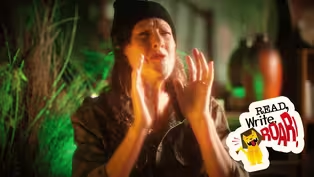Read, Write, ROAR!
Rescue at Sleeping Bear Dunes | Ms. Rodgers | Read, Write, ROAR!
Clip: Season 1 Episode 1007 | 8m 7sVideo has Closed Captions
Learn how rescues happen at Sleeping Bear Dunes with Ms. Rodgers!
Learn how rescues happen at Sleeping Bear Dunes with Ms. Rodgers! Find out why some visitors get stranded and how much it costs to be rescued from the steep dunes.
Problems playing video? | Closed Captioning Feedback
Problems playing video? | Closed Captioning Feedback
Read, Write, ROAR! is a local public television program presented by Detroit PBS
Read, Write, ROAR!
Rescue at Sleeping Bear Dunes | Ms. Rodgers | Read, Write, ROAR!
Clip: Season 1 Episode 1007 | 8m 7sVideo has Closed Captions
Learn how rescues happen at Sleeping Bear Dunes with Ms. Rodgers! Find out why some visitors get stranded and how much it costs to be rescued from the steep dunes.
Problems playing video? | Closed Captioning Feedback
How to Watch Read, Write, ROAR!
Read, Write, ROAR! is available to stream on pbs.org and the free PBS App, available on iPhone, Apple TV, Android TV, Android smartphones, Amazon Fire TV, Amazon Fire Tablet, Roku, Samsung Smart TV, and Vizio.
Providing Support for PBS.org
Learn Moreabout PBS online sponsorshipoh way why would you have to pay to be rescued this can't be true K hello everyone I'm Miss Rogers have you ever heard something and thought wait is that really true maybe you saw it online or even heard it from a friend well today I'll show you a cool way to be a detective and find out for yourself we'll learn how to fact check by using a simple tool called the t-chart to compare different sources and uncover the truth I'll model this for you so you can try it on your own sometime a t-chart is a graphic organizer that helps us compare information from different sources it's called a t-chart because it looks like the letter T we can use it to organize the information we find in different articles videos or books and compare them on the left side of the t- chart we'll write what we learned from the First Source and on the right side we'll write down what we learned from the Second Source this will help us see if both sources say the same thing or if there are differences I found two articles that I think will help us get to the bottom of this Sleeping Bear rescue situation let's read them to check the accuracy of the post I saw earlier is it true you may have to pay to be rescued from Sleeping Bear Dunes after we read the first article we'll complete our te- chart with the details we learn guide to Sleeping Bear Doom's National lak Shore how to hike stay safe what to bring it depends on who helps you and how but if Glen Lakes fire department gets called to the scene and Machinery gets involved you may have to Shell out serious cash to reimburse officials for their efforts a sprained ankle at the top of an Overlook for example probably wouldn't cost you Glenn lak's Fire Department chief Brian Ferguson said however if you need to be taken out on an ATV or carried by hand by firefighters that may fall into their basic rescue category which cost about $652 the next level up is a specialized rescue which can cost $1,630 if Mutual Aid is called out a boat is needed or the US Coast Guard has to break out its helicopter visitors could shell out $2,280 for the advanced technical rescue Ferguson said hm Mutual Aid that was new to me but see that they talk about additional Transportation or agencies like the US Coast Guard it must mean that if other partners are used the amount of money for the rescue increases I guess that makes sense because all their time and resources cost money now let's start completing our tea chart what are some details we learned about rescues at sleeping be Dooms according to the article if the Glenn Lakes fire department helps out at the dunes you might have to pay depending on how you are rescued for example a basic rescue could cost about $652 and a more advanced one with helicopter might cost $2,280 this tells us that yes there is a cost involved for rescue if special equipment is needed okay so we have one source that confirms what we saw on the social media posts but I have more questions now like why would someone need a helicopter rescue from the Dooms anyway and how often do these rescues happen let's see what information we can learn from the second article before we start let's preview a few vocabulary words we'll see overlooks are places where you can look at something from a higher spot Clarity means understanding an outling Community is an area that is far from the main city or town rescue efforts in the park are most common at overlooks number nine and 10 on Sleeping Bear famous Pier stocking Drive where the drop to the lake can be 450 ft down the Doom after warning signs got some social media attention this summer Glen Lakes firefighters took to their Facebook page to add some clarity first the fire department emphasize the number of personnel involved in the rescue when a visitor can't make it back up the Steep doing on their own it takes all on duty Personnel from both fire stations as well as several National Park Service Rangers to pitch in on the rescue since it's all hands on deck that means First Responders from outling communities then would have to fill in if there is another local emergency while the Glen Lake Fire Fighters are tending to a park rescue this is one reason for rescue Chargers to reduce responses to this location so we can adequately provide services to those who pay for them firefighter said in their Facebook post Additionally the cost of the equipment needed for a rescue adds to the nearly $3,000 fee for example rescue rope is routinely left in disrepair following a complex sandune operation according to the public post okay this article gives us a bit more information about rescues and why they are necessary rescues at Sleeping Bear Dooms can cost up to $3,000 especially for rescues at overlooks number 9 and 10 the reason for the high cost is because it takes a lot of firefighters and equipment to help people get back up the Steep Dooms and the cost helps make sure they can still respond to other emergencies in the area now that we filled in the t- chart let's compare what we've learned from both articles both sources agree that you may have to pay if you need to be rescued at sleeping be dun article one list the specific cost for different types of rescues like using an ATV or a helicopter Article 2 doesn't give cost for specific types of rescues but it gives more info about why rescues at sleeping beer are needed and why they can be expensive using a t-chart like this helps us understand important details in this case we now know that people might have to pay to be rescued at Sleeping Bear Dooms because rescue requires a lot of resources both articles tell us that there's a cost and by cross referencing the two texts we get a clearer picture of why the cost is so high so I guess the video I saw online was true after all learning how to cross reference information is important because not all sources will say the same thing by comparing information we find from multiple sources we can make sure that what we've learned is accurate and complete next time you're watching or reading something try using a tart to help you organize and check the information you hear it's a great way to be sure that what you've learned is true see you next time
Create a Camping Soundscape | Ms. Audra | Read, Write, ROAR!
Video has Closed Captions
Clip: S1 Ep1007 | 2m 3s | Hear owls, crackling fires, and more as you create your own camping soundscape. (2m 3s)
Squat to Overhead Press | Read, Write, ROAR! Restore
Video has Closed Captions
Clip: S1 Ep1007 | 2m 38s | Energize yourself with Ms. AP’s 2-minute snack, adding an arm twist to your squats. (2m 38s)
Unlocking Leadership: Skills for Success Explained | Ms. Yarnell | Read, Write, ROAR!
Video has Closed Captions
Clip: S1 Ep1007 | 4m 10s | Learn how to become a leader by guiding others, making wise choices, and working together. (4m 10s)
Using Figurative Language in Writing | Mrs. DeFauw | Read, Write, ROAR!
Video has Closed Captions
Clip: S1 Ep1007 | 5m 42s | Enhance your writing with figurative language while exploring Michigan’s unique beaches and dunes. (5m 42s)
Providing Support for PBS.org
Learn Moreabout PBS online sponsorship

- Home and How To

Hit the road in a classic car for a tour through Great Britain with two antiques experts.












Support for PBS provided by:
Read, Write, ROAR! is a local public television program presented by Detroit PBS




